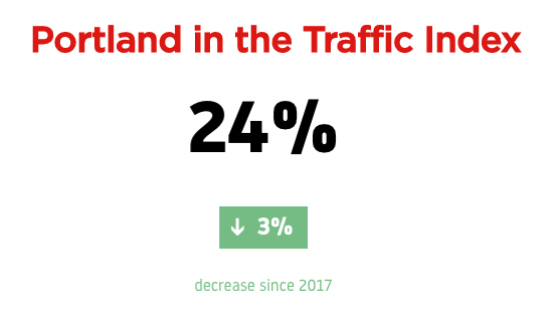What City Observatory did this week
1. Myth-busting: Building new market rate housing doesn’t drive up nearby rents. A favorite assertion of some housing supply-side skeptics is the theory that building new market rate housing in a neighborhood drives up rents in the immediate area. It’s a mistaken analogy to the idea of “induced demand” in transportation. The idea is that expensive new housing makes an area more desirable, and rents rise nearby. A new study uses fine-grained data on changes in rents around newly constructed market-rate apartment buildings in eleven strong-market cities around the country to test this theory. It finds that new buildings tend to depress the level of rents and rent increases in their immediate vicinity. The myth of “induced demand” for housing driving up rents is busted.
2. Inefficient and inequitable subsidies for electric vehicles. Subsidizing electric vehicle purchases is an expensive way to reduce carbon emissions, and mostly subsidizes rich households who would have bought electric vehicles anyhow. There’s a new study from the National Bureau of Economic Research that looks at the effectiveness and distribution of the electric vehicle (EV) purchase credits. The study concludes:
- Most people who got the subsidies would have bought an electric vehicle even without the subsidy.
- Electric vehicles mainly substitute for highly efficient internal combustion engine or hybrid vehicles
- The net cost of reducing a ton of carbon with electric vehicle subsidies is $552 — at the high end of such strategies.
- Most of the benefits of EV subsidies go to high income households
3. Portland records nation’s biggest decline in congestion–and nobody cares. This week, traffic data provider TomTom came out with its global congestion rankings, and Portland recorded the biggest decline in congestion of any US city. You think it would be cause for civic celebration, and trumpeting effective policies. But neither the media nor the state transportation department paid the slightest attention. The reason: traffic engineers really don’t care about reducing congestion. Congestion statistics and rankings are just public relations fodder for selling the next big freeway widening project. If they paid any attention to data, engineers would notice that higher gas prices and road pricing seem to be the only things that consistently lead to lower levels of congestion.
Must read
1. San Francisco Sierra Club position paper on housing. For a long time, San Francisco’s Sierra Club has been closely allied with the NIMBY side of the housing debate. That’s generated a considerable amount of ridicule: increasing density in cities is one of the best ways to reduce sprawl and pressure to develop environmentally sensitive areas. A new position paper from the Sierra Club shows a dramatic shift in position. Entitled “Unpacking Myths about housing development in the Bay Area” the paper makes a strong YIMBY case for supporting an increase in housing supply in San Francisco (and by extension, elsewhere in California cities. The paper takes on common NIMBY arguments about displacement, traffic, loss of local control, and “neighborhood character.” It appears that this change of heart has come too late, however, to make a material difference in the battle in Sacramento to adopt Senator Scott Wiener’s SB 50, which would legalize apartment construction near transit stops.
2. Rent control: Stockholm’s syndrome. Some advocates harbor a naive belief that if we could just take capital (or capitalism) out of the housing market we could solve the housing affordability and availability problem. The Guardian has a short article offering some insight into how such systems work in practice. Stockholm has long had a strong system of rent control, with about 40 percent of the region’s residents living in rent controlled apartments. While those fortunate enough to get apartments enjoy low rents (the equivalent of $600 monthly for a modest apartment), the city has a severe shortage and more than 500,000 people are on the waiting list for housing, with an expected wait of 20 to 30 years to get a unit. The shortage means there’s a black market for rent controlled units, with people illegally subletting units or paying bribes to become a favored tenant.
“It is almost impossible for immigrants and new arrivals to penetrate this market – it is all about who you know and how much money you have,” McCormac [head of the local property management association] says. Students, young people and immigrants are consequently shut out, and ethnic and social segregation is increasing.
Throttling the market doesn’t eliminate the underlying shortage of housing, nor does it magically create a better way to allocate apartments. (Hat tip to Market Urbanism).
3. More lying about highway widening. At City Observatory, we’ve chronicled the long series of lies told by the Oregon Department of Transportation in its efforts to sell a half-billion dollar widening of the I-5 freeway in Portland. Apparently, there was a seminar on this best practice at AASHTO, as we’re seeing it spread to other states. Alissa Walker of Curbed reports on the Maryland Department of Transportation’s phony claim that speeding freeway traffic will reduce carbon emissions–a claim we’ve repeatedly debunked here at City Observatory. Cars consume more fuel and generate more CO2 at higher speeds, and importantly (and ignored by the DOTs) reducing congestion prompts more traffic, and the effect of this induced demand more than offsets any efficiency from lowered idling. CO2 increases with VMT and MPH!
In the News
Phys.org‘s article “Traffic congestion reconsidered” cited our analysis showing the increase in traffic congestion that resulted after the widening of Houston’s Katy Freeway.
StrongTowns republished Joe Cortright’s essay, “Change is a constant in most neighborhoods.”
The Oregonian quoted City Observatory’s Joe Cortright in its article, “Construction gridlock: Portland area faces years long stretch of freeway, street and bridge projects.”


